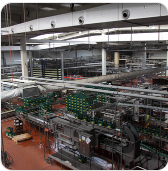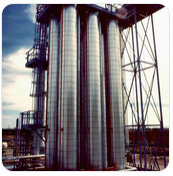Single-Minute Exchange of Die (SMED) for Quick Changeovers
In many process plants, equipment changeovers (the time to switch from one product to the next) are 100% non-value-added downtime. Reducing these changeovers through Lean SMED techniques frees up capacity, enabling more production time and smaller batches. By converting setup steps into ones that can be done while equipment is running, then streamlining what remains, SMED targets setup times in the “single-digit minutes”.

Faster changeovers cut costs and inventories: they allow smaller production lots and steadier flow, reducing lead times and on-hand inventory. For example, one study notes short changeovers lead to “lower inventory and lower waste” while broadening lot-size flexibility. Historically, Toyota applied these ideas in the 1950s–60s, slashing die-changeovers on presses from hours down to minutes. Today, SMED is used across industries (food, beverage, chemical, etc.) to achieve similar gains.
How SMED Works: Stages and Strategies
SMED follows a systematic, iterative process. A typical SMED improvement workshop includes these steps:
- Observe the current changeover in detail (often using video) to map every step.
- Separate internal vs. external tasks. Internal steps (like unbolting parts) can only be done while the machine is stopped; external tasks (like fetching tools or pre-heating parts) can be done before or after the changeover while production runs.
- Convert more tasks to external. For example, pre-assemble fixtures and pre-heat equipment so the actual changeover moves faster.
- Streamline remaining internal steps. Simplify or eliminate motions: use standardized fasteners or “one-touch” clamps so bolts don’t need multiple turns.
- Streamline external steps. Make even the setup actions efficient (e.g. using carts or staging areas) so external prep is quick and reliable.
- Document the new procedure in standard work forms, and train teams on the revised steps.
- Repeat and improve. Each iteration of these steps typically yields large gains – often ~45% reduction per cycle – so multiple SMED cycles are run until the changeover reaches a targeted single-digit duration.
Throughout, common Lean tools apply: visual work charts, “point-to-point” (spaghetti) diagrams to eliminate needless walking, and swim-lane flowcharts to identify parallel tasks. For example, one analysis recommends plotting a detailed timing map of the changeover so delays and waiting (red) versus active work (blue) stand out – as shown in the case study in Figure 8. The key is to ask at each step: Can this task be moved outside the downtime, simplified, or done in parallel?
Click Here to Download Readymade Lean Manufacturing, Six Sigma, Lean Six Sigma, ISO 9001, ISO 14001, ISO 22000, ISO 45001, FSSC 22000, HACCP, Food Safety & Integrated Management Systems (IMS) Templates.
Techniques and Best Practices
Effective SMED projects use these technical tactics:
- Pre-position materials and tools. Bring all parts, tools, and fixtures to the line before the last good part is made. For example, pre-staging label rolls or kegs means no searching during the stoppage.
- Quick-release mechanisms. Replace bolts or adjusters with quick-release clamps and standard fittings. One study notes “the last turn of a bolt tightens it – the rest is just movement,” so using quick connects and pre-set guides eliminates repetitive wrench turns.
- Parallel operations. Train multiple operators to work simultaneously. If two people can change parts in parallel without interfering, overall change time shrinks (labor hours remain similar).
- Standardization and checklists. Use labeled racks, color-coding, and checklists so tasks are done in the right order without delay. For example, the line-side cleaning trolley might be placed by maintenance crews rather than operators (saving 75–120s per change). Standard parts (same type of bolts or gaskets) mean one spanner does multiple jobs.
- Pre-adjustments and pre-heating. Pre-warm ovens or heaters during the last production run; calibrate gauges in advance. In one case, simply pre-heating a sealing head on a spare line saved 310 seconds of waiting each change. When more complex, specialized “line-hopping” strategies can be used: overlapping runs on parallel lines to minimize idle time during lengthy tasks.
These and other tactics are tailored to each plant. For example, color-coded shadow boards for tools, point-of-use storage carts, or simple jigs for alignment are common improvements found during SMED analyses. Importantly, operators and engineers collaborate on SMED so that “new attitudes on controllability” are instilled – line personnel prefer setups designed into the process, and easier setups generally have lower skill requirements.
Benefits: Uptime, Smaller Batches, Lower Inventory
Reduced downtime directly raises equipment utilization. Each minute saved in setup is a minute more producing saleable product. SMED also unlocks smaller batch sizes: because changeovers are fast, production can switch products to match demand more quickly, avoiding large runs and excess stock. In practice, companies report dramatic productivity jumps. For example, one case cut labeling-machine changeovers from 45 minutes down to 6 minutes – a ~87% reduction – by pre-staging labels and using quick-change parts, allowing operators to change multiple fixtures in parallel.
Generally, SMED projects yield 30–75% setup reduction. A survey found most SMED “kaizens” cut setup time by about 50–75%. (In the ready-meal plant study below, an initial SMED effort cut changeovers by 30%; with an advanced line-hopping change, they shaved nearly 68% off the original time.) Typical effects include: higher OEE (more good output per hour) and lower labor per part, since less crew time is tied up in idle changeover work. For instance, the food-plant case reported a jump in OEE from ~62% to 71% after SMED.
Faster changeovers also trim inventory and floor space. By driving toward “stockless production,” SMED accelerates inventory turnover. With smaller lots, WIP and finished-goods buffers shrink; plus, the flexibility allows mixing of production to meet demand, rather than producing in large batches “just in case”. Ultimately, lean experts note these gains: lower manufacturing costs, smoother flow, and improved ability to meet varied demand. In the ready-meal example, the 30% shorter changeover time translated to 3.3 million extra pots per year (3300 production hours saved), illustrating how modest time cuts multiply through high-throughput lines.
Click Here to Download Readymade Lean Manufacturing, Six Sigma, Lean Six Sigma, ISO 9001, ISO 14001, ISO 22000, ISO 45001, FSSC 22000, HACCP, Food Safety & Integrated Management Systems (IMS) Templates.
Case Studies and Metrics
The following examples illustrate SMED results in different process settings:
| Example / Equipment | Before (setup) | After (SMED) | Change |
|---|---|---|---|
| Ready-meal packaging line (food industry) | 29.0 minutes | 20.0 minutes (SMED) | –30% |
| Beverage bottling – label change | 45.0 minutes | 6.0 minutes (SMED) | –87% |
| Offset printing press – feeder | 221.3 minutes | 167.3 minutes (SMED) | –24.4% |
| Offset printing press – coater | 79.5 minutes | 49.5 minutes (SMED) | –37.8% |
| Offset printing press – stacker | 55.0 minutes | 30.0 minutes (SMED) | –45.5% |
These cases show that even initially long changeovers can fall to minutes. In all cases, the SMED strategy was similar: externalize as much as possible and streamline internal tasks. For the ready-meal line, implementing just six targeted improvements (like staging and cleaning reassignments) cut the 29-min changeover to 20 min, yielding huge annual production gains. In a beverage plant, applying SMED to the labeler (pre-staging labels, quick-connects, and parallel crews) cut time from 45 to 6 min. In offset printing, SMED flowcharts and new fixturing reduced feeder and coater changeover by roughly 24–38%, and stacker by ~45%.

In chemical and related process industries (paints, plastics, etc.), the stakes are similar. SMED adaptations may include extra flushing steps, or scheduling campaign-lengths to balance changeover cost against inventory risk. But the core principle holds: minimize the non-producing time so that more capacity serves current demand. (Indeed, process SMEs observe that long changeovers in batch chemical plants drive high inventories and overproduction waste.) In practice, even a chemical filler line that requires sanitation between products can benefit. For example, by pre-cleaning or using modular skids, one plant halved its cleaning time, enabling shorter campaigns. The image above exemplifies such equipment – imagine redesigning its large valves and flushing operations for quick exchange to keep production running at pace.
Click Here to Download Readymade Lean Manufacturing, Six Sigma, Lean Six Sigma, ISO 9001, ISO 14001, ISO 22000, ISO 45001, FSSC 22000, HACCP, Food Safety & Integrated Management Systems (IMS) Templates.
Implementation Advice
For plant managers and engineers, successful SMED implementation means: form cross-functional teams, use data (timing sheets, videos), and invest in training. Track key metrics: measure “changeover time” from last good piece to first good piece, and set targets (often aiming below 10 minutes). Prioritize high-frequency or critical machines – those running many different products or with the longest setups. Lean consultants recommend combining SMED with Total Productive Maintenance and changeover management systems to sustain gains.
In summary, SMED is a powerful Lean tool for process plants. By breaking setups into tasks and relentlessly eliminating waste, companies gain agility. Quicker changeovers directly translate to higher throughput and flexibility – enabling smaller batch sizes and lower inventory – while also improving quality (fewer rush errors) and safety (standardized procedures). The evidence is clear: organizations that shorten their changeovers free up capacity for customer demand, reduce costs, and make their operations far more competitive.
Click HERE to download or any of the following documents:
Integrated Management Systems (IMS) Implementation
IATF 16949 Automotive Quality Management Implementation Kit
ISO/IEC 17025 Laboratory Management System Implementation Kit
HACCP Implementation Kit
ISO 9001 Quality Management Systems (QMS) Implementation
ISO 22000 Food Safety Management Systems (FSMS) Implementation
Food Safety Systems Certification (FSSC) 22000 v5 Implementation
ISO 14001 Environmental Management Systems (EMS) Implementation
ISO 45001 Occupational Health & Safety Management Systems (OH&SMS) Implementation
ISO 50001 Energy Management Systems (EnMS) Implementation
Industrial Health, Safety & Environmental Management (HSE) Kit
Process Manuals
SON Compliance Documentation Kit
NAFDAC Compliance Documentation Kit
QA/QC Documentation Kit
Equipment Maintenance Documentation Kit
Production Management Documentation Kit
Production, Quality Control / Equipment Maintenance Kit
Lean Six Sigma
Lean Management/Manufacturing
Six Sigma Kit
Supplier Quality and Compliance Management (SQCM) Kit
Risk Management